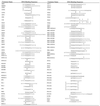The Homeodomain Resource: sequences, structures, DNA binding sites and genomic information
- PMID: 11125116
- PMCID: PMC29851
- DOI: 10.1093/nar/29.1.291
The Homeodomain Resource: sequences, structures, DNA binding sites and genomic information
Abstract
The Homeodomain Resource is an annotated collection of non-redundant protein sequences, three-dimensional structures and genomic information for the homeodomain protein family. Release 3.0 contains 795 full-length homeodomain-containing sequences, 32 experimentally-derived structures and 143 homeo-box loci implicated in human genetic disorders. Entries are fully hyperlinked to facilitate easy retrieval of the original records from source databases. A simple search engine with a graphical user interface is provided to query the component databases and assemble customized data sets. A new feature for this release is the addition of DNA recognition sites for all human homeodomain proteins described in the literature. The Homeodomain Resource is freely available through the World Wide Web at http://genome.nhgri.nih.gov/homeodomain.
Figures

References
-
- Gehring W., Qian,Y., Billeter,M., Furukubo-Tokunaga,K., Schier,A., Resendez-Perez,D., Affolter,M., Otting,G. and Wuthrich,K. (1994) Homeodomain-DNA recognition. Cell, 78, 211–223. - PubMed
-
- Laughon A. (1991) DNA binding specificity of homeodomains. Biochemistry, 30, 11357–11367. - PubMed
-
- Dekker N., Cox,M., Boelens,R., Verrijzer,C., van der Vliet,P. and Kaptein,R. (1993) Solution structure of the POU-specific DNA-binding domain of Oct-1. Nature, 362, 852–855. - PubMed
-
- Viglino, P., Fogolari,F., Formisano,S., Bortolotti,N., Damante,G., Di Lauro,R. and Esposito,G. (1993) Structural study of rat thyroid transcription factor 1 homeodomain (TTF-1HD) by nuclear magnetic resonance. FEBS Lett., 336, 397–402. - PubMed
-
- Gruschus J., Tsao,D., Wang,L., Nirenberg,M. and Ferretti,J. (1997) Interactions of the vnd/NK-2 homeodomain with DNA by nuclear magnetic resonance spectroscopy: basis of binding specificity. Biochemistry, 36, 5372–5380. - PubMed
MeSH terms
Substances
LinkOut - more resources
Full Text Sources
Research Materials

